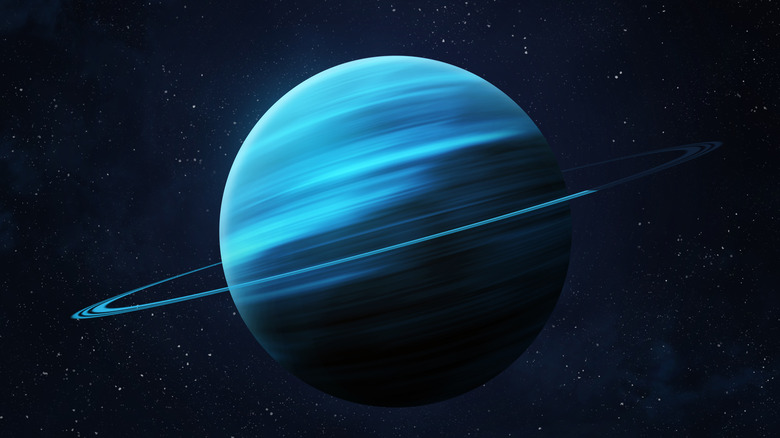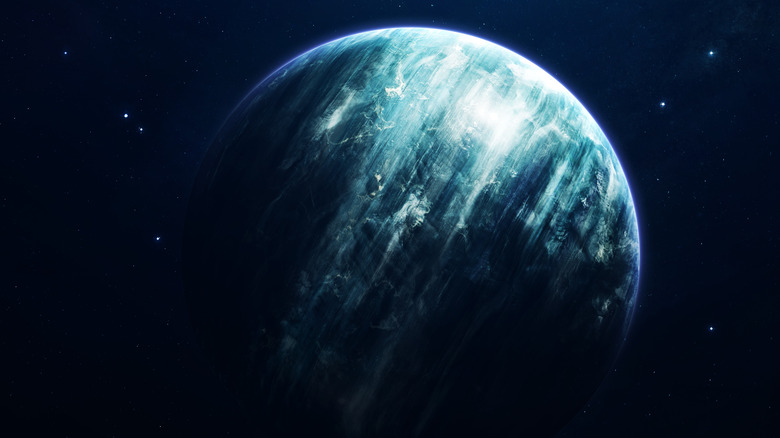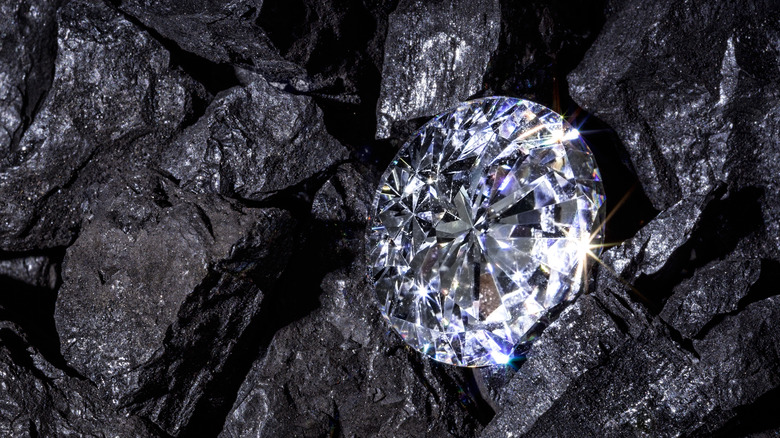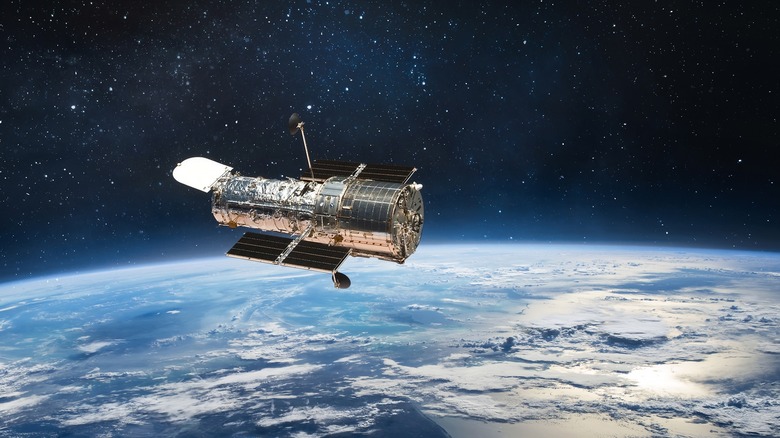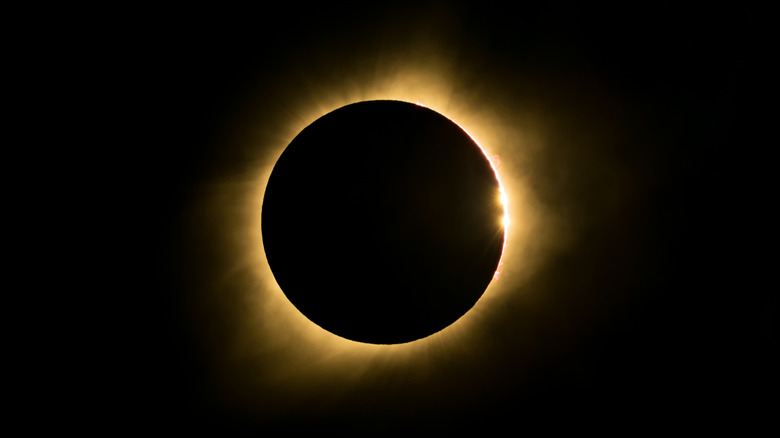The Hidden Secret Uranus And Neptune Might Be Holding
Our solar system's two coldest, darkest, murkiest planets — Uranus and Neptune — hide a glittering secret. Deep below their opaque blue atmospheres, giant diamonds sink through the planets' dense mud-like oceans. For a while, scientists have guessed that Neptune and Uranus were home to this diamond rain, says Popular Science. But recently, researchers came close to confirming it through experiments replicating the unique diamond-creating conditions found on the two planets.
Even more exciting, NASA plans to send a mission to Uranus to learn more. In April 2022, NASA released a "to do" list of upcoming projects, including a years-long mission to Uranus, reports Forbes. The mission would arrive in Uranus's orbit by 2045. The main spacecraft would orbit the planet for years and collect data. At the same time, a probe would descend below the planet's atmosphere to document the until-now-guessed-at mantle — and likely diamond rain below (via Nature Magazine posted on Scientific American).
This mission could shed light on our solar system and the galaxy beyond. Our solar system is actually a little unusual. In other places in the Milky Way, ice giants like Uranus and Neptune are more than 10 times more common than gas giants like Jupiter. So the more we know about our ice giants, the more we can learn about the planets beyond our solar system, writes Science Alert.
What is it like on Neptune and Uranus?
Neptune and Uranus are ice giants, explains Space. Though the name "ice giants" may conjure images of snow and glaciers, neither can be found on the planets. Instead, they are mostly made out of water, methane, and ammonia, which scientists call "ices." According to Popular Science, the planets have small rocky cores surrounded by a mantle. (Mantles are the bulky layer between a planet's core and surface, writes Astronomy.) Uranus and Neptune both have mantles that are slurry, meaning semi-liquid, semi-solid mixtures made of water, ammonia, and methane ices. Think of oceans, but made of thick mud. Finally, the planets are covered in a thick atmosphere.
Researcher and scientist at Helmholtz Zentrum Dresden-Rossendorf, Dominik Kraus, thinks that the diamond rain covers a large swath around the planets' cores. Though, he posits that the range of diamond rain could be a lot larger. "If the temperature is high enough close to the core (some calculations predict that) it could also be 'oceans of liquid carbon' with gigantic 'diamond icebergs, swimming on top of it," he explains (via Smithsonian Magazine). "But most theories suggest that diamond would remain solid, at least inside Neptune and Uranus, but this may be different for some exoplanets."
How does diamond rain work?
Making diamond rain is like any earthly food recipe: you need ingredients and heat, except at astronomical levels. You also need a whole lot of pressure. Popular Science explains that our solar system's two ice giants are actually hot, at least partially. Just think about how our Earth has habitable temperatures on the surface but a fiery radioactive core on the inside (via National Geographic). The outer surface of Neptune and Uranus is still cold — very cold — due to their far distance from the sun. But, as you move closer to the core, the planets' pressure increases, making everything hotter.
In theory, at about 5,000 miles below the atmosphere's surface, this heat — combined with the significant amounts of pressure — could be the perfect conditions for hydrogen and carbon to create raining diamonds, according to scientific models. Under that pressure, methane breaks apart and releases carbon, which combines and forms long chains. The pressure then squeezes the carbon chains together, creating crystalized structures — diamonds. These diamonds then move down through the goopy mantle toward the core, getting hotter and hotter. Eventually, they get so hot that they vaporize. According to Space, the carbon floats to the top of the mantle, and the process starts over again.
How do we know about diamond rain?
Because of Neptune's and Uranus' opaque and thick outer layers, we're still unsure what truly happens on our ice giants, says Popular Science. Of course, all of that will change after NASA's 2045 mission. For now, the only spacecraft to get close to Neptune and Uranus was Voyager 2, launched in 1977. The craft passed by Neptune and Uranus but didn't get a close look underneath the planets' atmosphere, according to Space.
As of now, scientists mostly rely on observation with a telescope, laboratory experiments mimicking likely planetary conditions, and mathematical models. Models are calculations about what could be occurring on the planets using available information, writes Space. This mathematical modeling using the known information about Neptune and Uranus, combined with laboratory experiments, gives us clues about the hypothetical diamonds raining down on the two planets.
In 2017, scientists were able to simulate the process of making diamonds within Uranus-like conditions, reports Popular Science. "Previously, researchers could only assume that the diamonds had formed," Dominik Kraus said. "When I saw the results of this latest experiment, it was one of the best moments of my scientific career."
Creating diamond rain on the earth
In order to recreate the conditions for diamond rain in a lab, scientists had to reproduce the ice giant's hot temperatures and extreme pressure, says Popular Science. They also needed hydrogen and carbon, the elements that likely make up Uranus' raining diamonds. Luckily the plastic polystyrene (Styrofoam) is made of hydrogen and carbon and was the experiment's material of choice, writes Space.
The researchers used a laser that sent a pair of shockwaves through the polystyrene for heat and pressure. The shockwaves briefly simulated the intense heat and pressure found below Uranus' atmosphere. Per Science Alert, Dominik Kraus equated the force to "the pressure exerted by the weight of some 250 African elephants on the surface of a thumbnail." Of the experiment, Kraus said, "That we saw this very clear signature of diamonds was actually very, very surprising."
While the lab experiment created tiny diamonds (only a few billionths of a meter wide), scientists predict Uranus' diamonds could be much bigger. According to Popular Science, the diamonds on Uranus could grow to weigh millions of carrots over thousands of years. This experiment helps us understand the far reaches of our solar system. Also, it might help us create small diamonds here at home. Notably, Smithsonian Magazine says that this ice-giant production style could give the makers of small diamonds for electronics and surgical tools a new method for manufacturing their products.
What other gems might exist in outer space?
Beyond raining diamonds, the galaxy holds many possibilities, including entire planets made of precious gems, according to Discover Magazine. Since diamonds are made of carbon and carbon is abundant in the universe, given the right conditions — like the heat and pressure on Uranus — they're highly likely found elsewhere. "We can form all sorts of gemstones potentially in space, as long as you have the right chemistry in the right temperature and conditions," Wendy Mao, a professor of geological sciences at Stanford University, explained to Discover Magazine.
While diamonds and precious gems in space remain mostly theoretical, we have some physical evidence of their existence, dating as far back as 1886. That year, in the Mordovia Republic of Russia, ureilite meteorites hit the town of Novy Urey (eventually, scientists named the meteorites after the village). Upon investigation, the meteorites contained diamonds, though what forces created the diamonds is still up for debate, says Discover Magazine.
Mars may also hold precious stones. Opal requires water and volcanic activity, and both have occurred on Mars. Opaline silica, a key component of opal, has been identified on the planet. Researchers predict that the universe could hold rubies, sapphires, and other earthly gems. For now, we are left to wonder what other celestial treasures hide in the night sky.
